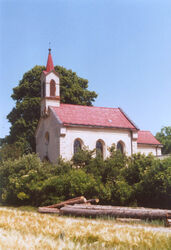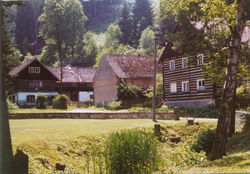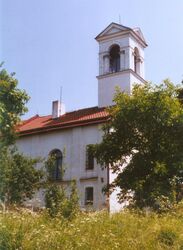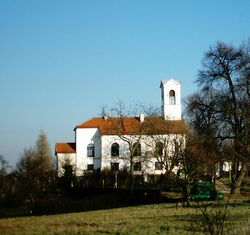Brusné - a little village on the very tail of the Kokořín Valley. Population (2005) : 1.
 Hradsko – 315 m above sea level, little village over the Kokořín Valley. This tiny hamlet opens upon a plateau protected by sandstone cliffs and is accessible by road from NE and several steep routes only. Originally, a prehistoric and later an Old-Slavonic fortified settlement. Known as an excavation site with numerous archeological findings (cremation burial site, cinerary urns, bronze weapons). Augustin Sedláček identified this location as ”Canburg ”, a fortified settlement, which was, according to some franconian manuscripts, under an unsuccessful siege at the beginning of the 9th century. During excavations, a 9th-C-nobleman’s farmstead together with a graveyard section from 10th-12th C were uncovered. The church of St. George, originally Romanesque, was re-erected in 1874. Hradsko is the setting of Eduard Štorch’s novel ”Zastavený příval.” The surroundings offer many attractive scenes of the Kokořín Valley, the Kokořín Castle, as well as plenty of far-away regions. Population (2005) : 11.
Hradsko – 315 m above sea level, little village over the Kokořín Valley. This tiny hamlet opens upon a plateau protected by sandstone cliffs and is accessible by road from NE and several steep routes only. Originally, a prehistoric and later an Old-Slavonic fortified settlement. Known as an excavation site with numerous archeological findings (cremation burial site, cinerary urns, bronze weapons). Augustin Sedláček identified this location as ”Canburg ”, a fortified settlement, which was, according to some franconian manuscripts, under an unsuccessful siege at the beginning of the 9th century. During excavations, a 9th-C-nobleman’s farmstead together with a graveyard section from 10th-12th C were uncovered. The church of St. George, originally Romanesque, was re-erected in 1874. Hradsko is the setting of Eduard Štorch’s novel ”Zastavený příval.” The surroundings offer many attractive scenes of the Kokořín Valley, the Kokořín Castle, as well as plenty of far-away regions. Population (2005) : 11.
Olešno – 330 m above sea level, folk architecture preserve – timbered buildings, campanile. Protected lime-trees (lime being the Czech national tree). Population (2005): 2.
 Ráj – 255 m above sea level, a road intersection at the northern edge of the Kokořín Valley and at the outer boundary of the Konrádov Valley. Several recreational edifices representing the traditional folk architecture of this region.
Ráj – 255 m above sea level, a road intersection at the northern edge of the Kokořín Valley and at the outer boundary of the Konrádov Valley. Several recreational edifices representing the traditional folk architecture of this region.
A renewed memorial of the WWI fallen. Favorite destination of tourists seeking relaxation in our region – a restaurant, a buffet, a boarding house (pension).
A lumbermill. A horse-breeding farm in vicinity, horse-riding courses, horseback-trips available. Population (2005): 11.
 Romanov – 390 m above sea level, located on a hillock NW off Mšeno with several homesteads, and a Neoclassicist chapel from 1890 reconstructed into a recreational edifice. The once seat of lords and authorities from Mšeno comprised of a chapel consecrated to St. Roman (adjacent was a spacious burial site for the neighboring villages) and a castle, which was constructed in the 15th C. In 1724, count Jan Hynek Věžník ( then a holder of the Mšeno domain) ordered that the castle be pulled down and the material transported to Lobeč and there made use of for construction purposes of the Lobeč castle. In 1766 Romanov was, together with all its land and fields, bought out by Mšeno and later even the dilapidated chapel would go through reconstruction and expansion. This was consecrated to St. Magdalene. Two years later, a stations of the cross with 14 little chapels was built on the road from Mšeno to Romanov, and here performances about Christ’s martyrdom would be put. These performances were banned in 1798 by the provincial administration all over the country and consequently the stations of the cross suffered the administrative consequences and was ordered to be
Romanov – 390 m above sea level, located on a hillock NW off Mšeno with several homesteads, and a Neoclassicist chapel from 1890 reconstructed into a recreational edifice. The once seat of lords and authorities from Mšeno comprised of a chapel consecrated to St. Roman (adjacent was a spacious burial site for the neighboring villages) and a castle, which was constructed in the 15th C. In 1724, count Jan Hynek Věžník ( then a holder of the Mšeno domain) ordered that the castle be pulled down and the material transported to Lobeč and there made use of for construction purposes of the Lobeč castle. In 1766 Romanov was, together with all its land and fields, bought out by Mšeno and later even the dilapidated chapel would go through reconstruction and expansion. This was consecrated to St. Magdalene. Two years later, a stations of the cross with 14 little chapels was built on the road from Mšeno to Romanov, and here performances about Christ’s martyrdom would be put. These performances were banned in 1798 by the provincial administration all over the country and consequently the stations of the cross suffered the administrative consequences and was ordered to be  destroyed accordingly. As Mšeno lacked financial resources to cover the maintenance of the chapel - the former place of occasional festivals, carnivals and other town festivities, and later even of mass meetings- it would gradually keep decaying in the whole course of the 19th C. The Romanov hilltop offers views mainly over the North and East in the direction of the Vrátenská hora (Vrátenská Mountain), Housecké vrchy (Housecké hills) and towards Bezděz (the Bezděz hills with ruins of the Bezděz castle on top of one of the two). The gamekeeper’s lodge Romanov (at Na rovinách) – crossing of many natural trails (numerous rocky glens, Švédský val – “Swedish bulwark”). Nearby up north in one of the glens one can find a man-made grotto Obraznice, which, during the Thirty Year’s war, served as a hiding place and a stash of valuables (including canvas masterpieces) of the Romanov manorial seat, which found its end in 1724. A place of work of an ethnographer, archeologist and an awakener Václav Krolmus. Population (2005): 8.
destroyed accordingly. As Mšeno lacked financial resources to cover the maintenance of the chapel - the former place of occasional festivals, carnivals and other town festivities, and later even of mass meetings- it would gradually keep decaying in the whole course of the 19th C. The Romanov hilltop offers views mainly over the North and East in the direction of the Vrátenská hora (Vrátenská Mountain), Housecké vrchy (Housecké hills) and towards Bezděz (the Bezděz hills with ruins of the Bezděz castle on top of one of the two). The gamekeeper’s lodge Romanov (at Na rovinách) – crossing of many natural trails (numerous rocky glens, Švédský val – “Swedish bulwark”). Nearby up north in one of the glens one can find a man-made grotto Obraznice, which, during the Thirty Year’s war, served as a hiding place and a stash of valuables (including canvas masterpieces) of the Romanov manorial seat, which found its end in 1724. A place of work of an ethnographer, archeologist and an awakener Václav Krolmus. Population (2005): 8.
Sedlec – 350 m above sea level, the villages prides itself with an archeological excavations site located on its outer edge. Located below the village are a grotto Barcalína and Kočičina hollow. A lumbermill, and a restaurant. Population (2005) : 114.
Skramouš - 310 m above sea level, village NE off Mšeno, next to the 076 Mělník – Mladá Boleslav railway line. Amidst the village stands a protected big-leaf lime tree (a 4-meter-in girth one). Population (2005) : 30.
Vojtěchov – 250 m above sea level, a recreational village (resort for many cottagers) in the upper part of the Kokořín Valley, 4 km west off Mšeno. Founded in the 18th C at the order of knight Beneda as a part of the Stránka manor. At that time a brewery stood there. In the NE part of the village there is a still visible trace of the former brewery- a brewery pond (these days called Vojtěchovská tůň), irrigated by creek Pšovka. Above it across the road lies a wooded bank Stříbrník, at whose foot stands a water tank in which a drinking water drained from the surrounding rock rifts and the nearby Planý důl (Planý hollow) is gathered. The tank is used as a reservoir supplying drinking water for a large part of the Mělník county. Folk architecture. Pšovka wetlands. Birthplace of the first Czech female physician Dr. Anna Bayerová (1852-1924). Population (2005): 9.
